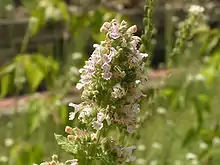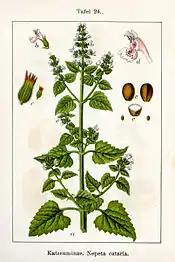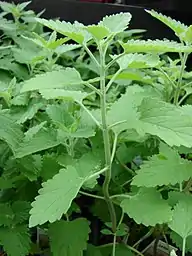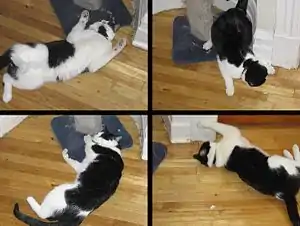Catnip
Nepeta cataria, commonly known as catnip, catswort, catwort, and catmint, is a species of the genus Nepeta in the family Lamiaceae, native to southern and eastern Europe, the Middle East, Central Asia, and parts of China. It is widely naturalized in northern Europe, New Zealand, and North America.[1][2][3][4][5] The common name catmint can also refer to the genus as a whole.
| Catnip | |
|---|---|
 | |
| Catnip flowers | |
| Scientific classification | |
| Kingdom: | Plantae |
| Clade: | Tracheophytes |
| Clade: | Angiosperms |
| Clade: | Eudicots |
| Clade: | Asterids |
| Order: | Lamiales |
| Family: | Lamiaceae |
| Genus: | Nepeta |
| Species: | N. cataria |
| Binomial name | |
| Nepeta cataria | |
The names catnip and catmint are derived from the intense attraction about two-thirds of cats have toward them (alternative plants exist).[6][7] In addition to its uses with cats, catnip is a popular ingredient in herbal teas (or tisanes), and is valued for its sedative and relaxant properties.[8][9]
Description
Nepeta cataria is a short-lived perennial, herbaceous plant that grows to be 50–100 cm (20–40 in) tall and wide, which blooms from late spring through autumn. In appearance, N. cataria resembles a typical member of the mint family of plants, featuring brown-green foliage with the characteristic square stem of the plant family Lamiaceae.[10] The coarse-toothed leaves are triangular to elliptical in shape.[11] The small, bilabiate flowers of N. cataria are fragrant and are either pink in color or white with fine spots of pale purple.[11]
Taxonomy
Nepeta cataria was one of the many species described by Linnaeus in 1753 in his landmark work Species Plantarum.[12] He had previously described it in 1738 as Nepeta floribus interrupte spicatis pedunculatis (meaning "Nepeta with flowers in a stalked, interrupted spike"), before the commencement of Linnaean taxonomy.[13]
Uses


The plant terpenoid nepetalactone is the main chemical constituent of the essential oil of Nepeta cataria. Nepetalactone can be extracted from catnip by steam distillation.[14]
Cultivation
Nepeta cataria is cultivated as an ornamental plant for use in gardens. It is also grown for its attractant qualities to house cats and butterflies.[11]
The plant is drought-tolerant and deer-resistant. It can be a repellent for certain insects, including aphids and squash bugs.[11] Catnip is best grown in full sunlight and grows as a loosely branching, low perennial.[15]
Varieties include Nepeta cataria var. citriodora (or N. cataria subsp. citriodora), or "lemon catnip".[16]
Biological control
The compound iridodial, extracted from catnip oil, has been found to attract lacewings that eat aphids and mites.[17]
As an insect repellent
Nepetalactone is a mosquito and fly repellent.[18][19] Oil isolated from catnip by steam distillation is a repellent against insects, in particular mosquitoes, cockroaches and termites.[20][21] Research suggests that, while a more effective spatial repellant than DEET,[22] it is not as effective as a repellent when used on the skin when compared with SS220 or DEET.[23]
Effect on humans
Catnip has a history of use in traditional medicine for a variety of ailments.[24] The plant has been consumed as a tisane, juice, tincture, infusion, or poultice, and has also been smoked.[24] However, its medicinal use has fallen out of favor with the development of modern medicine.[24]
Effect on felines

Catnip contains the feline attractant nepetalactone. N. cataria (and some other species within the genus Nepeta) are known for their behavioral effects on the cat family, not only on domestic cats, but also other species.[24] Several tests showed that leopards, cougars, servals, and lynxes often reacted strongly to catnip in a manner similar to domestic cats; while lions and tigers can react strongly as well, they do not react as consistently.[25][26][27][28]
With domestic cats, N. cataria is used as a recreational substance for pet cats' enjoyment, and catnip and catnip-laced products designed for use with domesticated cats are available to consumers. Common behaviors cats display when they sense the bruised leaves or stems of catnip are rubbing on the plant, rolling on the ground, pawing at it, licking it, and chewing it. Consuming much of the plant is followed by drooling, sleepiness, anxiety, leaping about, and purring. Some growl, meow, scratch, or bite at the hand holding it.[29][30] The main response period after exposure is generally between 5 and 15 minutes, after which olfactory fatigue usually sets in.[31]:p.107
Cats detect nepetalactone through their olfactory epithelium, not through their vomeronasal organ.[32] At the olfactory epithelium, the nepetalactone binds to one or more olfactory receptors.
A study published in January 2021 suggests that felines are specifically attracted to the iridoids nepetalactone and nepetalactol, present in catnip and silver vine, respectively.[33] The compounds were found to repel mosquitos, and it is hypothesized that rubbing against the plants provides the cats with a chemical coat that protects them against mosquito bites.[33][34]
Felines not affected by catnip
About one-third of cats are not affected by catnip.[6][7][24][35] The behavior is hereditary. Other plants that have a catnip-like effect on cats include valerian (Valeriana officinalis) root and leaves; silver vine (Actinidia polygama), or matatabi, popular in Asia; and Tatarian honeysuckle (Lonicera tatarica) wood. Many cats that do not respond to catnip do respond to one or more of these three alternatives.[6][7]
A 1962 pedigree analysis of 26 cats in a Siamese breeding colony suggested that the catnip response was caused by a Mendelian-dominant gene, but a 2011 pedigree analysis of 210 cats in two breeding colonies (taking into account measurement error by repeated testing) showed no evidence for Mendelian patterns of inheritance but demonstrated heritabilities of h2 = 0.51–0.89 for catnip response behavior, indicating a polygenic liability threshold model.[24][36][37]
References
- "Nepeta cataria". Germplasm Resources Information Network (GRIN). Agricultural Research Service (ARS), United States Department of Agriculture (USDA). Retrieved 7 April 2008.
- World Checklist of Selected Plant Families: Royal Botanic Gardens, Kew
- Flora of China Vol. 17 Page 107 荆芥属 jing jie shu Nepeta Linnaeus, Sp. Pl. 2: 570. 1753.
- Altervista Flora Italiana, genere Nepeta includes photos plus range maps for Europe and North America
- Wilson, Julia. "Catnip (Nepeta cataria) - Everything You Need to Know About Catnip! | General Cat Articles". www.cat-world.com.au. Archived from the original on 6 February 2015. Retrieved 6 October 2015.
- Bol, Sebastiaan (16 March 2017). "Responsiveness of cats (Felidae) to silver vine (Actinidia polygama), Tatarian honeysuckle (Lonicera tatarica), valerian (Valeriana officinalis) and catnip (Nepeta cataria)". BMC Veterinary Research. 13 (1): 70. doi:10.1186/s12917-017-0987-6. PMC 5356310. PMID 28302120.
- "Catnip (Nepeta cataria) – Everything You Need to Know About Catnip!". Cat-World.com.au. Cat World. 2014. Archived from the original on 6 February 2015. Retrieved 2 January 2015.
- "Catnip tea". HealthLine.com. Retrieved 10 July 2019.
- Grognet, Jeff (1990). "Catnip: Its uses and effects, past and present". The Canadian Veterinary Journal. 31 (6): 455–456. PMC 1480656. PMID 17423611.
- "Archived copy". Archived from the original on 14 October 2013. Retrieved 11 August 2013.CS1 maint: archived copy as title (link)
- Missouri Botanical Garden: Nepeta cataria (Catmint) . Retrieved 1 October 2013
- Linnaeus C (1753). "Tomus II". Species Plantarum (in Latin). Stockholm: Laurentii Salvii. p. 570.
- Roger Spencer, Rob Cross & Peter Lumley (2007). "Latin names, the binomial system and plant classification". Plant Names: a Guide to Botanical Nomenclature (3rd ed.). CSIRO Publishing. pp. 14–15. ISBN 9780643099456.
- "DIY Kitty Crack: ultra-potent catnip extract". Instructables. 3 June 2007. Retrieved 14 February 2009.
- "Growing Catnip - Bonnie Plants". Retrieved 27 August 2016.
- Kathi Keville (2016). The Aromatherapy Garden: Growing Fragrant Plants for Happiness and Well-Being (illustrated ed.). Timber Press. p. 133. ISBN 9781604695496.
- Agricultural Research. May/Jun2007, vol.55 Issue 5, p7-7. 1p.
- Kingsley, Danny (3 September 2001). "Catnip sends mozzies flying". ABC Science Online. Retrieved 14 February 2009.
- Junwei J. Zhu, Christopher A. Dunlap, Robert W. Behle, Dennis R. Berkebile, Brian Wienhold. (2010). Repellency of a wax-based catnip-oil formulation against stable flies. Journal of Agricultural and Food Chemistry, 58 (23): 12320–12326 (8 Nov 2010, doi:10.1021/jf102811k).
- Schultz, Gretchen; Peterson, Chris; Coats, Joel (25 May 2006). "Natural Insect Repellents: Activity against Mosquitoes and Cockroaches" (PDF). In Rimando, Agnes M.; Duke, Stephen O. (eds.). Natural Products for Pest Management. ACS Symposium Series. American Chemical Society.
- "Termites Repelled by Catnip Oil". Southern Research Station, United States Department of Agriculture – Forest Service. 26 March 2003.
- "Catnip Repels Mosquitoes More Effectively Than DEET". www.sciencedaily.com. Retrieved 16 July 2016.
- Chauhan, K.R.; Klun, Jerome A.; Debboun, Mustapha; Kramer, Matthew (2005). "Feeding Deterrent Effects of Catnip Oil Components Compared with Two Synthetic Amides Against Aedes aegypti". Journal of Medical Entomology. 42 (4): 643–646. doi:10.1603/0022-2585(2005)042[0643:FDEOCO]2.0.CO;2. PMID 16119554.
- Grognet J (June 1990). "Catnip: Its uses and effects, past and present". The Canadian Veterinary Journal. 31 (6): 455–456. PMC 1480656. PMID 17423611.
- Reader's Digest: Does Catnip "Work" On Big Cats Like Lions And Tigers? Accessed 22 May 2015
- Chris Poole (2 August 2010). Q: Do Tigers Like Catnip?. Big Cat Rescue. Retrieved 2 January 2015.
- Chris Poole (19 March 2013). Q: Do Tigers Like Catnip? Part 2. Big Cat Rescue. Retrieved 22 March 2015.
- Durand, Marcella (4 March 2003). "Heavenly Catnip". CatsPlay.com. Archived from the original on 15 May 2013. Retrieved 2 January 2015.
- Becker, Marty; Spadafori, Gina (2006). Why Do Cats Always Land on Their Feet?: 101 of the Most Perplexing Questions Answered About Feline Unfathomables, Medical Mysteries and Befuddling Behaviors. Deerfield Beach, Florida: Health Communications, Incorporated. ISBN 0757305733.
- Spadafori, Gina (2006). "Here, Boy!". Universal Press Syndicate. Retrieved 3 May 2014.
- Arden Moore (20 July 2007). The Cat Behavior Answer Book: Solutions to Every Problem You'll Ever Face; Answers to Every Question You'll Ever Ask. Storey. ISBN 978-1-60342-179-9. Retrieved 18 July 2013.
- Hart, Benjamin L.; Leedy, Mitzi G. (July 1985). "Analysis of the catnip reaction: mediation by olfactory system, not vomeronasal organ". Behavioral and Neural Biology. 44 (1): 38–46. doi:10.1016/S0163-1047(85)91151-3. PMID 3834921.
- Moutinho, Sofia; 2021; Pm, 2:00 (20 January 2021). "Why cats are crazy for catnip". Science. Retrieved 28 January 2021.CS1 maint: numeric names: authors list (link)
- Wu, Katherine J. (20 January 2021). "Your Cat Isn't Just Getting High Off Catnip". The New York Times. ISSN 0362-4331. Retrieved 28 January 2021.
- Turner, Ramona (29 May 2007). "How does catnip work its magic on cats?". Scientific American. Retrieved 14 February 2009.
- Todd 1962, "Inheritance of the catnip response in domestic cats"
- Villani 2011, "Heritability and Characteristics of Catnip Response in Two Domestic Cat Populations"
Further reading
- Khan, M.A.; Cameron, M.M.; Loza-Reyes, E. (May 2012). "Interference in foraging behaviour of European and American house dust mites Dermatophagoides pteronyssinus and Dermatophagoides farinae (Acari: Pyroglyphidae) by catmint, Nepeta cataria (Lamiaceae)". Experimental and Applied Acarology. 57 (1): 65–74. doi:10.1007/s10493-012-9532-2. PMID 22382713. S2CID 17494631.
External links
| Wikispecies has information related to Catnip. |
| Look up catnip in Wiktionary, the free dictionary. |
| Wikimedia Commons has media related to Nepeta cataria. |
